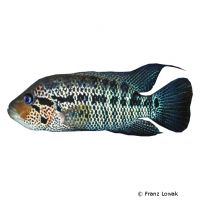False Yellowjacket Cichlid (Parachromis motaguensis)
| False Yellowjacket Cichlid Parachromis motaguensis | |
|---|---|
| Name | False Yellowjacket Cichlid |
| Name Lat. | Parachromis motaguensis |
| Synonym | Heros motaguensis |
| Family | Cichlids |
| Family lat. | Cichlidae |
| Order | Cichlids |
| Order lat. | Cichliformes |
| Origin | Central America |
| Habitat | Rivers, lakes |
| Diet | Carnivore |
| pH | 7.0-8.0 |
| Behavior | Predatory, aggressive |
| Keeping | Individual, pair |
| Care Level | Difficult |
| Reproduction | Substrate spawner |
| Breeding | Moderately difficult |
| Life Span | 10-15 years |
| Protection | No |
| Metric Units | |
| Size | 30 cm |
| Temperature | 20-28 °C |
| Hardness | 6-18 °dH |
| Aquarium | 600 l |
| US Units | |
| Size | 12" |
| Temperature | 68-82 °F |
| Hardness | 107-320 ppm |
| Aquarium | 160 gal |
Distribution and habitat
The distribution area of the tiger cichlids is the catchment area of the Rio Montagua on the Atlantic side and from the Rio Naranjo to the Rio Choluteca on the Pacific side of Guatemala and Honduras. They live in rivers and lakes with muddy bottoms, stones, roots and dead wood.
Maintenance
The aquarium should have plenty of hiding places, with rocks, rock structures and roots, as well as plenty of swimming space. A deep, sandy substrate for burrowing and some subdued light (floating plants) is ideal.
No ammonia, ammonium or nitrite should be detectable, and the nitrate level should not exceed 100 mg/l. To ensure the water quality and oxygen content, a filter and heater adapted to the aquarium size is required, as well as lighting for the species-appropriate day-night rhythm of the animals.
Diet
The diet for these predatory fish consists of live or frozen foods, such as mysis, red mosquito larvae, krill, shrimp with shell and clam meat, or a commercial frozen special food mix for large cichlids, as well as earthworms or meal beetle larvae for adults. After acclimation, high-quality, protein-rich dry food for cichlids (pellets, granules) is also accepted.
Only as much should be fed as is eaten immediately (in a maximum of 10 minutes). Regular and varied feeding promotes health and increases resistance.
Behaviour and compatibility
They are very aggressive cichlids, also intraspecific and behave extremely territorial not only at spawning time. Keeping several animals is only possible in a much larger and richly structured tank. They can only be socialized with larger and robust fish. Fish that are too small are considered prey.
Basically, only compatible fish species with similar demands on water quality and water temperature may be socialized.
Sex dimorphism
The sexes are hardly distinguishable. The males are lighter colored with slightly more green parts.
Reproduction and breeding
Once a pair has formed, breeding is easy. However, it should be remembered that up to 2,000 fry can develop from one clutch
They spawn on shallow rocks or roots (open brooders). Both parents engage in intensive brood care (parental family) and vigorously defend the territory. After 2-3 days, the fry hatch and are then housed and guarded in a bottom pit until they swim freely after 5-7 days. The school of fry is guarded by the parents for some time.
Fry must be fed several times a day with special rearing food (e.g. Artemia nauplii).
Important
They like to burrow, accordingly, need to secure stone structures. Plants should be placed in heavy pots and secured with stones against rooting, but planting is not necessary.
In nature they can grow up to 55 cm and are a popular food fish.
The well-being of the fish should be checked regularly. Temperature should be checked daily, pH, hardness and nitrate levels at least fortnightly. Regular partial water changes are recommended, even if the contaminant level has not yet reached the upper limit. Sudden changes in water quality should be avoided. Newly introduced fish must be accustomed slowly to the water in the aquarium.
Further literature can be found in your pet store.
References
Text: Werner Winter; Image: Franz Lowak
Source: BMELV (1998): Tierschutzgutachten - Haltung von Zierfischen (Süßwasser); RIEHL & BAENSCH (2004): Aquarien Atlas Bd. 3, Mergus Verlag; ENGELMANN (2005): Zootierhaltung - Tiere in menschlicher Obhut: Fische, Verlag Harri Deutsch
- Gemäß § 21 Abs. 5 Tierschutzgesetz idgF
